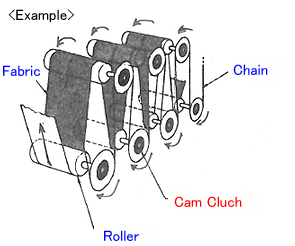Applications Cam Clutch - 9. Fabric dryer
Application
Overrunning
An application to alternately repeat the conditions where the inner and outer races of the cam clutch engage to transmit the torque and where they continue spinning around depending on the difference in the rotation speed or rotation direction. The operation is the same as the free wheeling of a car.
Supporting model(s)
- ・MZ Series
- ・Special cam clutch
Adopting machine
Fabric dryer
Applications
Layout

This equipment is used for drying dyed fabrics and yarns by passing them across the rollers placed in the upper and lower positions through a furnace. All the rollers are rotated by chains in the same direction at the same speed. The fabric on the rollers, however, shrinks as it dries through the rollers. Consequently, some rollers rotate faster than the speed driven by the chain according to the amount of shrinkage. When a cam clutch is attached to the sprocket on which the chain is mounted, the cam clutch (in the figure, the inner race) overruns to adjust the rotation of the roller.
Purpose of Use and Operation Overview
The sprocket is connected with the outer race of the cam clutch. The rotation is transmitted from the outer race to the inner race (roller) through the engagement of the cam clutch.

When the fabric or yarn becomes dry and the roller starts rotating faster than the rotation driven by the chain (outer race side), the inner race of the cam clutch overruns. Rotation driven by the chain: Blue Faster rotation of the roller: Green

When Tsubaki's cam clutches are used ・・・
It is necessary to select the cam clutch based on the roller shaft diameter, necessary torque, rotation speed, and other criteria. You can select a cam clutch according to your usage conditions, sprocket model number, and mounting method. Moreover, you can select specifications suited to your lubrication requirements such as high ambient temperature.
Advantage of using the cam clutch
- ・The cam clutch switches between overrunning and engagement automatically simply based on the difference in the rotation speed.
- ・Smooth speed change is ensured without the need for a device controlling speed differences.

